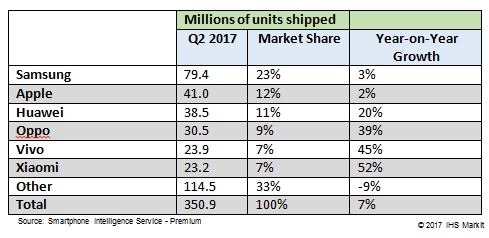[테크월드=이나리 기자] Preliminary data from IHS Markit shows that the global smartphone market grew by 7 percent year-over-year, to 350.9 million units, from 320 million units in Q2 2016. Leaders of the pack Samsung, Apple, Huawei, Oppo and vivo all grew, while Xiaomi reversed its recent performance and just missed out on a top-five spot.
The market continues to be driven by Chinese OEMs, which have optimized their operations in China. OEMs operating on the global stage, such as Apple or Samsung, saw modest growth as established markets for these companies continue to mature.
Samsung shipped 79.4 million smartphones in the quarter, up 3 percent from the year-ago result of 77.4 million units. The launch of the Galaxy S8 / S8 Plus helped deliver 11 percent year-over-year revenue growth to 28.92 trillion KRW. However, market share of Samsung declined to 23 percent in the quarter, down from 24 percent in the year earlier. Samsung has been struggling in China market as the strong top-three OEMs (Huawei, Oppo and vivo) are dominating the market.
Apple reported a 2percent growth in unit shipments for the quarter, shipping 41 million units in the quarter compared to 40.4 million units last year. Apple has been able to grow its shipments year-over-year in light of consumer anticipation for the launch of the next, anniversary edition, of the iPhone later this summer or early fall. Reinforcing the overall market trend towards larger screens, Apple continues to see strong demand for the premium iPhone 7 Plus model.

Huawei continues to hold the number three position globally, shipping 38.5 million smartphone units in the quarter – an increase of 20 percent from a year ago. Huawei’s market share increased to 11 percent, narrowing the gap with Apple by 1 percentage point in the second quarter. Huawei benefitted from the availability of its flagship P10 devices for all of Q2, even if the device is not performing as well as the P9 in the year prior. Huawei’s Honor brand continues to do well. Huawei keeps growingits international business, something its Chinese competition has not been able to replicate.
Oppo and vivo continued their growth stories in Q2 2017. Oppo grew 39 percent, from 21.9 million units in Q2 2016 to 30.5 million units in the most recent quarter. Vivo had an even higher growth rate, 45 percent, from 16.4 million units in Q2 2016 to 23.9 million units in Q2 2017. In both cases, the Chinese market supports the companies’ growth. Both companies gained the market share by 2 percentage points from the previous year, taking 9 percent and 7 percent, respectively, in the quarter.
Lastly, Xiaomi reversed a sliding trend from the last four quarters in which the company’s shipments declined from 15.2 million units in Q2 2016 to 12.8 million units in Q1 2017, by shipping 23.2 million units in Q2 2017. This represents growth of 52 percent year-over-year – just missing a spot in the top five globally by 0.7 million units. Increased retail channel availability in China and growth in its international markets, like India and Russia, are responsible for this growth. Xiaomi was able to separate itself from its closest competitors LG, Lenovo and ZTE.
The rest of the market declined by 9 percent year-over-year. This number includes LG, which declined from 13.9 million units shipped last year to 13.3 million units this quarter. The launch of the G6 earlier this year, featuring a trend hardware feature in its 18:9 aspect-ratio display, has not enabled LG to consolidate – or grow – its position in the market.
The upcoming launches of the next Note and iPhone devices loom large on the horizon for performances in Q3 and beyond – both have the potential to be catalysts for continued growth for the overall smartphone market in 2017 and going into 2018.
그래도 삭제하시겠습니까?



